The OCZ Vertex 3 Review (120GB)
by Anand Lal Shimpi on April 6, 2011 6:32 PM ESTAnandTech Storage Bench 2011
I didn't expect to have to debut this so soon, but I've been working on updated benchmarks for 2011. Last year we introduced our AnandTech Storage Bench, a suite of benchmarks that took traces of real OS/application usage and played them back in a repeatable manner. I assembled the traces myself out of frustration with the majority of what we have today in terms of SSD benchmarks.
Although the AnandTech Storage Bench tests did a good job of characterizing SSD performance, they weren't stressful enough. All of the tests performed less than 10GB of reads/writes and typically involved only 4GB of writes specifically. That's not even enough exceed the spare area on most SSDs. Most canned SSD benchmarks don't even come close to writing a single gigabyte of data, but that doesn't mean that simply writing 4GB is acceptable.
Originally I kept the benchmarks short enough that they wouldn't be a burden to run (~30 minutes) but long enough that they were representative of what a power user might do with their system.
Not too long ago I tweeted that I had created what I referred to as the Mother of All SSD Benchmarks (MOASB). Rather than only writing 4GB of data to the drive, this benchmark writes 106.32GB. It's the load you'd put on a drive after nearly two weeks of constant usage. And it takes a *long* time to run.
I'll be sharing the full details of the benchmark in some upcoming SSD articles but here are some details:
1) The MOASB, officially called AnandTech Storage Bench 2011 - Heavy Workload, mainly focuses on the times when your I/O activity is the highest. There is a lot of downloading and application installing that happens during the course of this test. My thinking was that it's during application installs, file copies, downloading and multitasking with all of this that you can really notice performance differences between drives.
2) I tried to cover as many bases as possible with the software I incorporated into this test. There's a lot of photo editing in Photoshop, HTML editing in Dreamweaver, web browsing, game playing/level loading (Starcraft II & WoW are both a part of the test) as well as general use stuff (application installing, virus scanning). I included a large amount of email downloading, document creation and editing as well. To top it all off I even use Visual Studio 2008 to build Chromium during the test.
Update: As promised, some more details about our Heavy Workload for 2011.
The test has 2,168,893 read operations and 1,783,447 write operations. The IO breakdown is as follows:
| AnandTech Storage Bench 2011 - Heavy Workload IO Breakdown | ||||
| IO Size | % of Total | |||
| 4KB | 28% | |||
| 16KB | 10% | |||
| 32KB | 10% | |||
| 64KB | 4% | |||
Only 42% of all operations are sequential, the rest range from pseudo to fully random (with most falling in the pseudo-random category). Average queue depth is 4.625 IOs, with 59% of operations taking place in an IO queue of 1.
Many of you have asked for a better way to really characterize performance. Simply looking at IOPS doesn't really say much. As a result I'm going to be presenting Storage Bench 2011 data in a slightly different way. We'll have performance represented as Average MB/s, with higher numbers being better. At the same time I'll be reporting how long the SSD was busy while running this test. These disk busy graphs will show you exactly how much time was shaved off by using a faster drive vs. a slower one during the course of this test. Finally, I will also break out performance into reads, writes and combined. The reason I do this is to help balance out the fact that this test is unusually write intensive, which can often hide the benefits of a drive with good read performance.
There's also a new light workload for 2011. This is a far more reasonable, typical every day use case benchmark. Lots of web browsing, photo editing (but with a greater focus on photo consumption), video playback as well as some application installs and gaming. This test isn't nearly as write intensive as the MOASB but it's still multiple times more write intensive than what we were running last year.
As always I don't believe that these two benchmarks alone are enough to characterize the performance of a drive, but hopefully along with the rest of our tests they will help provide a better idea.
The testbed for Storage Bench 2011 has changed as well. We're now using a Sandy Bridge platform with full 6Gbps support for these tests. All of the older tests are still run on our X58 platform.
AnandTech Storage Bench 2011 - Heavy Workload
We'll start out by looking at average data rate throughout our new heavy workload test:
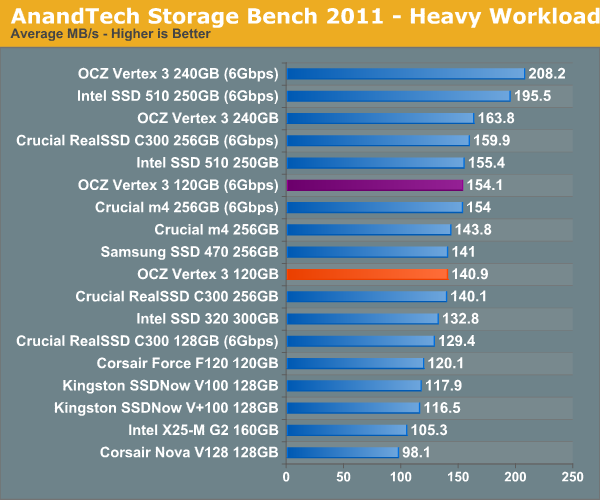
In our heavy test for 2011 the 120GB Vertex 3 is noticeably slower than the 240GB sample we tested a couple of months ago. Fewer available die are the primary explanation. We're still waiting on samples of the 120GB Intel SSD 320 and the Crucial m4 but it's looking like this round will be more competitive than we originally thought.
The breakdown of reads vs. writes tells us more of what's going on:

Surprisingly enough it's not read speed that holds the 120GB Vertex 3 back, it's ultimately the lower (incompressible) write speed:
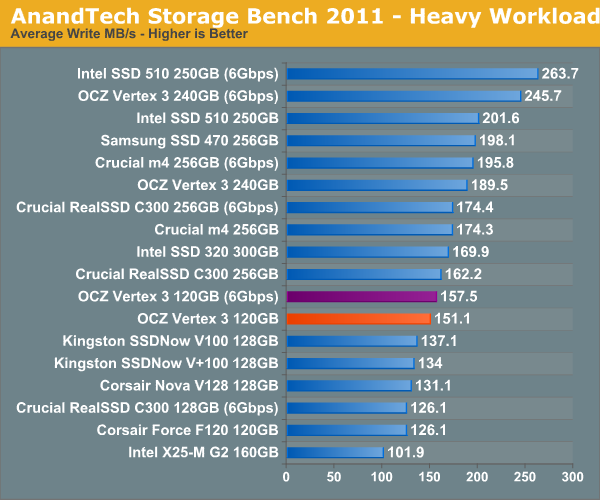
The next three charts just represent the same data, but in a different manner. Instead of looking at average data rate, we're looking at how long the disk was busy for during this entire test. Note that disk busy time excludes any and all idles, this is just how long the SSD was busy doing something:
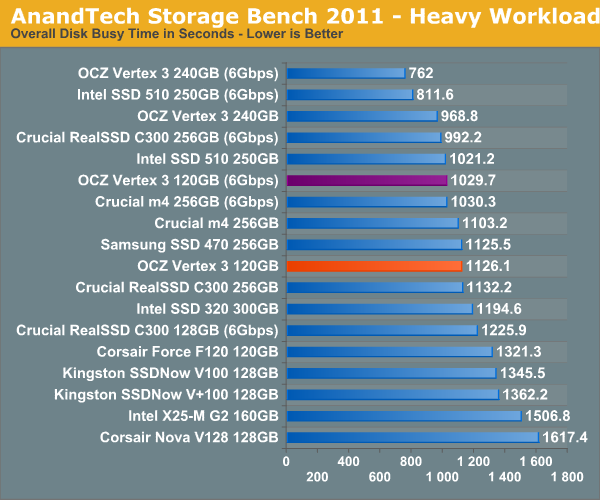
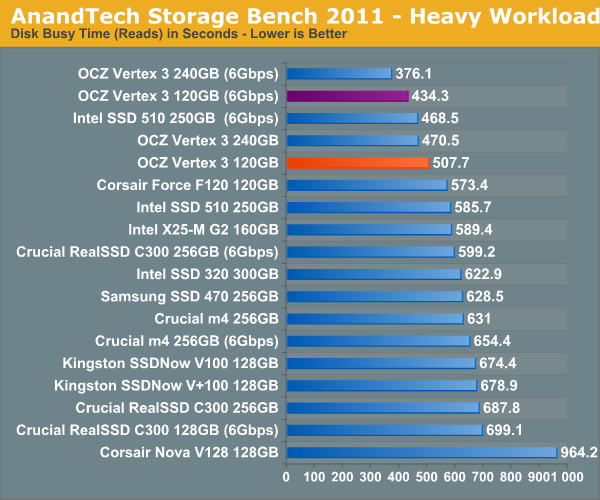
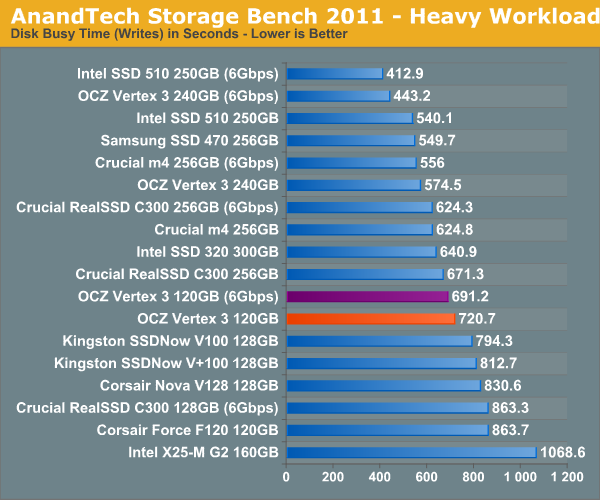










153 Comments
View All Comments
SolidSteel144 - Wednesday, April 6, 2011 - link
Why weren't other controllers tested?AMD's SB850 should also be able to handle these drives at full speed.
A5 - Wednesday, April 6, 2011 - link
If you go back and look at the Sandy Bridge launch article (http://www.anandtech.com/show/4083/the-sandy-bridg... you'll see that the Intel and AMD controllers have essentially identical performance. No reason to double his benchmark time for a 1% difference.acripps - Wednesday, April 6, 2011 - link
Newegg should have one to my door tomorrow......The last drop of my yule spending authorization. It will spend the next few years drifting through various machine incarnations....till it passes out of the pool in a give-away pc....somewhere around 2014.watzupken - Wednesday, April 6, 2011 - link
Following this issue I had with them, there won't be another OCZ product from me. Anand did point out a good thing that this issue is far from over since OCZ left buyers like myself and others out in the cold in the exchange. So other than the 60 and 120GB drives, no other drives are eligible for an exchange. Worst case, I got the affected drive back due to an exchange as the earlier drive failed. I return fast drive, get a slow drive back. How nice.devlabz - Wednesday, April 6, 2011 - link
Last few articles I ended up wondering why random read speed in SF controllers is slower than random write. I may have missed some important article explaining all that stuff, tho i read all of them. Isn't flash technology favoring the read speeds? Or it have something to do with lookups for the random data chunks?Most likely this will be the year where I'll try to get a SSD drive, and since my main reason will be to reduce the compilation times of my projects and I think that my biggest gain will be with highest random read IOPs drive? Am I wrong here? Or will it matter that much actually?
FunBunny2 - Wednesday, April 6, 2011 - link
I've read, don't remember where, that the IMFT 25nm NAND has on-die ECC circuitry. So:- did you find such
- is OCZ, or anyone, exercising it
???
Movieman420 - Wednesday, April 6, 2011 - link
Yeah...Tosh also just introduced their 'built-in ECC' nand.http://www.techpowerup.com/143619/Toshiba-Debuts-S...
The thing is, from what I understand anyway, that this nand will take the ECC burden off the controller. Thing is tho that SandForce controllers actually accell at ECC duties vs other controllers. This is a major selling point because as the die process continues to shrink, the ECC burden will continue to increase. So I guess I'm saying that I'm not too sure that more expensive ecc-nand would be practical if the controller doesn't suffer from the increasing ECC issue. Someone with more knowledge about how the SF controller works could probably answer the question best...cough*Anand*cough. ;)
Movieman420 - Wednesday, April 6, 2011 - link
The dismal performance of the Hynix nand was news to me. It does however explain why there were many users with horrid performance posting on the Ocz forums. I suspect these were the ones who where told that the problem was with their PC/Lappy. It has never once been mentioned on the forum that some drives may have low performing nand inside. No wonder they kept reminding folks not to open their drives 'due to potential warranty issues'. It seems Ocz was being less than forthcoming even before the whole 25nm nand thing blew up. I really really REALLY hope that Ocz puts an end to the shady business we've seem for the last few months...they are a great company with a great product. Omission and/or deception isn't gonna fly, especially when you cater to enthusiasts who are not exactly stupid. It's those same 'enthusiasts' who made Ocz's early success possible in the first place. I know that things have since changed and now the vast majority of their sales are to commercial and enterprise customers. They'd never think of pulling this with those customers, but they'll do it to the very people who made their early success possible in the first place? This post and my previous one come from the prospective of a die hard customer who also happens to be an Ocz shareholder as well. Just wish I could afford enough to actually have a say so in the way things go down. :Pxboxist - Wednesday, April 6, 2011 - link
Anand,I'm a very casual hardware enthusiast, and admittedly most of the technical aspects discussed in this article eludes me.
With that said, I don't need to understand everything to continue to be impressed by your enthusiasm for the products in your industry, and the way you carry yourself as an ambassador for all of your users. The way you went after OCZ here has to be applauded.
fixxxer0 - Wednesday, April 6, 2011 - link
after being disappointed in some way with just about every (large) company i've dealt with, whether it be insurance, auto makers, electronics, appliances, you name it... i am glad to see one finally accepting responsibility, and doing the right thing.i do not expect 100% perfection from every company at all times. i know sometime things are DOA, or defective, or flawed. but to actually have a company take that extra step and make it right without you having to sue them is commendable.
personally, when it comes time on deciding which drive to go with, it will mainly be on the numbers, but OCZ's ethics will definitely give them the edge if there is a toss up.